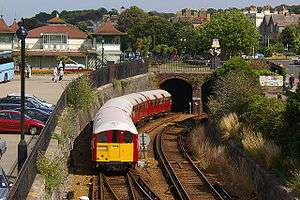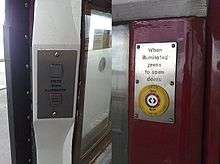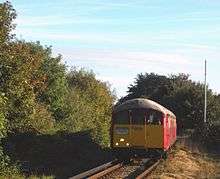British Rail Class 483
The British Rail Class 483 electric multiple units were originally built as 1938 tube stock units for London Underground. They were extensively refurbished between 1989 and 1992 by Eastleigh Works, for use on services on the Isle of Wight's Island Line. This was despite having already being used for nearly 50 years on the London Underground. The units replaced the even older and life-expired British Rail Classes 485 and 486 units which were introduced in 1967, but were originally built as 'Standard' stock units for the London Electric Railway in 1923.
| British Rail Class 483 | |
|---|---|
 A pair of Island Line Class 483s in London Underground livery entering the Ryde tunnel. | |
The extensively refurbished interior of an Island Line Class 483 EMU. | |
| In service | 1938-1988 on London Underground 1989-present on Island Line |
| Manufacturer | Metro-Cammell |
| Family name | Tube |
| Number in service | 2 trainsets |
| Predecessor | British Rail Classes 485 and 486 |
| Successor | Class 484 |
| Formation | 2 cars per trainset |
| Capacity | 84 seats (2 car set) |
| Operator(s) | Island Line |
| Depot(s) | Ryde depot |
| Specifications | |
| Train length | 2 coaches |
| Car length | 52 ft 3 3⁄4 in (15.94 m) |
| Maximum speed | 45 mph (72 km/h) |
| Weight | 55 t (54 long tons; 61 short tons) each 2 car set. |
| Power output | 500 kW (670 hp) total power per 2 car set. |
| Electric system(s) | 630 V DC 3rd rail |
| Current collection method | Contact shoe |
| Multiple working | Within class |
| Track gauge | 4 ft 8 1⁄2 in (1,435 mm) standard gauge |
The trains are 82 years old and still in service as of 2020, making it the oldest passenger train in Great Britain to remain in regular service. They are due to be replaced by Class 484s from late 2020.
History
Prior to Isle of Wight service
The trains were originally built by Metro-Cammell as 1938 tube stock for London Underground. An initial batch was withdrawn from service in 1973, and they were considered for use on the Island Line (which would not bear that name for another 16 years). However, the under-floor equipment was thought to be a problem, as extensive adaptations would be needed to Ryde Works to allow fitters to access it. It was also felt that the under-floor equipment would be vulnerable to salt water damage on Ryde Pier, especially in bad weather.[1]
The last batch of 1938 stock was withdrawn in 1985, except for five trains required on the Northern line between 1986 and May 1988 due to increasing passenger numbers. In 1987, Network SouthEast (NSE) managers realised that the existing 1923-built Class 485 trains would not be economically serviceable beyond around 1990 and thoughts turned to the future of the line. After closure of the route was discounted, it was decided to purchase and refurbish 1938 stock.[2]
In April 1988, London Underground offered a total of 28 carriages in revenue-earning condition to NSE, joined by three further carriages in May 1989. In addition, between May 1988 and October 1990, four scrap vehicles and nine works vehicles, to be used for spare parts, were taken from LU's Ruislip depot. While the project's feasibility study suggested that three-car units would be preferred, it was thought that the alterations required to Ryde depot would be both difficult and expensive. It was instead decided that two-car units would be used, using a maximum of six coaches in any train formation.[3] Of the 31 coaches available, 20 were selected for use on the island. These were extensively refurbished between 1989 and 1992 by Eastleigh Works to ready them for service on the line.

As well as cosmetic and structural work, significant electrical works were required both to replace dilapidated wiring, and to allow the trains to work from the line's third rail electrical supply.[4]
Eight two-car units were initially refurbished between 1989 and 1990. These units were numbered 483001-008, although only the final three digits were carried on the cab ends. Units were painted in the new Network SouthEast livery, of blue with red and white stripes. The first unit was tested on the South West Main Line between Basingstoke and Eastleigh before travelling to Fratton ready for its transfer to the island. Testing and crew training on the remaining units took place on the Portsmouth Direct Line and Shepperton Branch Line.[5][6]
On the island
The first unit, 001, arrived on the Isle of Wight on 5 July 1989 following an overnight ferry crossing from Portsmouth to Fishbourne. It was delivered by road to Sandown, then hauled to Ryde depot by one of the existing passenger trains. It began test running on the Island Line in the evening of 6 July, before a public launch on 13 July.[7] Regular passenger services using the Class 483 did not commence until October, while the last of the eight planned units did not enter service until July 1990.[8]
While it was originally planned to use only eight units, in 1992—two years after the rest of the fleet had entered service—the ninth unit, numbered 009, was also refurbished and transported to the island.[9] A 10th unit was also shipped to Ryde depot, although this was for spares only and was never used in passenger operation on the Island. This unit was unofficially given the unit number 483010.
Each unit was formed of two driving motor vehicles, numbered 121–129 and 221–229. The technical description of this formation was DMSO(A)+DMSO(B).
When the units were first introduced, the final digit of the unit number and the final digit of the carriage numbers corresponded, such that unit 001 was formed of vehicles 121 and 221. However, since then, a few rearrangements have taken place to the unit formations.
In 1996, with the privatisation of British Rail, the Ryde–Shanklin line became the Island Line franchise, which was won by the Stagecoach Group. Services continued to be branded as Island Line Trains. In 1999 three units (001, 003 and 005) were permanently withdrawn from service as surplus to requirements, leaving only six units remaining serviceable. In the early 2000s, the remaining units were overhauled and were repainted into a new livery of blue and yellow with pictures of dinosaurs. From 2007-2008, all units were repainted into their original London Transport red livery (albeit with yellow warning panels on the cab rather than the original red).[10][11]
According to an article in the October 2005 issue of Rail Professional magazine, at that time Island Line was paying "an eye-watering £140,000 a year" to lease the trains, meaning that "[s]ince privatisation, HSBC Rail has pocketed over £1m for leasing these relics that are effectively worthless."[12] In March 2007, South West Trains purchased the rolling stock outright from the leasing company HSBC Rail for £1.[13]
Further that year, the Island Line franchise was amalgamated with South West Trains as part of the new South Western franchise.
Refurbishment
The Class 483 trains were last refurbished during 2007; work on the six-vehicle fleet included:
- an exterior repaint into London Transport maroon with cream window pillars
- a retrim of the seat moquette into the same moquette that the London Underground A60/62 Surface Stock received during their refurbishment between 1993–98
When South Western Railway took over the franchise in 2017, it launched a consultation on the future of Island Line services, revealing that only 3 of the 6 remaining units were serviceable.[14] These trains did receive a fresh coat of paint, and currently bear its logo, along with 'Island Line' written on the side.
Replacement
On 13 September 2019, South Western Railway announced that because of a "safety issue" only one of the units was able to run, which meant cancelling just under half of scheduled services and running only an hourly service on the Island Line.[15] This reduction in service was by mid-September expected to last for approximately one month, until 14 October[16] but the company warned that the trains' age and increasing difficulty of getting spare parts meant it might take longer. Normal service was not been restored for approximately 5 weeks, but further fleet faults brought repeated disruption through much of November.[17] Just 3 days after the news that only one Class 483 was serviceable, on 16 September 2019 the government announced that the fleet would be replaced by five two-car Class 484s.[18]
Preservation
As these historic units approach withdrawal there has been some interest in the preservation of a Class 483 unit. One preservation attempt (for a full unit) is known to be ongoing, this being administered by a new organisation called the London Transport Traction Group who intend preserving a unit to run via an on-board power supply on the Epping Ongar Railway in Essex.[19] It is known that the Isle of Wight Steam Railway intends to represent the Class 483s in its collection, but full details are not currently publicly available. In 2017, the IoWSR stated in its Strategic Vision document that they intended to preserve some part of a unit as a static exhibit, although this is likely to have changed in the years since.[20] On 29 July 2020, SWR, the owner and operator, announced that it was looking for new homes for the trains as soon as possible, to make room for the influx of the first Class 484s for testing later in the year. SWR had already had numerous enquiries from perseveration groups, including the adjacent Isle of Wight Steam Railway. Organisations interested in adopting a soon to be former Island Train will need to show the capacity and financial security to remove and look after the train, as well as an appropriate long-term physical location for the train. [21]
Fleet details
Only three of the nine units remain serviceable as of August 2020 the remainder of the others having been taken out of service progressively since April 2000. Of these three serviceable units, only two are currently in service with the third currently under a long term overhaul.[22] On 29 July 2020 South Western Railway announced that the six extant units would be offered for preservation.[23]
| Key: | In service | Withdrawn | Scrapped |
|---|
| Unit No. | Vehicle Nos. | Delivered to LPTB | Livery | Status | Notes | ||||
|---|---|---|---|---|---|---|---|---|---|
| DMSO(A) | DMSO(B) | DMSO(A) | DMSO(B) | ||||||
| 483001 | 121 | ex-10184 | 221 | ex-11184 | 19 Aug 1939[24] | 19 Aug 1939[25] | Network SouthEast | Scrapped | Scrapped at Ryde St John's Road, June 2006. |
| 483002 | 122 | ex-10221 | 225 | ex-11142 | 13 Nov 1939[24] | 27 Feb 1939[25] | London Transport Red | Withdrawn | Stored at Ryde St John's Road since 2008 as a source of spare parts.[26] |
| 483003 | 123 | ex-10116 | 223 | ex-11116 | 10 Jan 1939[24] | 10 Jan 1939[27] | Network SouthEast | Scrapped | Previously stored in a siding near Ryde St John's Road as a source of spare parts. Scrapped in April 2000. |
| 483004 | 124 | ex-10205 | 224 | ex-11205 | 10 Oct 1939[24] | 10 Oct 1939[25] | London Transport Red | Withdrawn | Stored at Ryde St John's Road since 2019 as a source of spare parts. |
| 483005 | 125 | ex-10142 | 222 | ex-11221 | 27 Feb 1939[24] | 13 Nov 1939[25] | Network SouthEast | Scrapped | Scrapped at Ryde St John's Road, April 2000. |
| 483006 | 126 | ex-10297 | 226 | ex-11297 | 1 July 1940[27] | 1 July 1940[25] | London Transport Red | In service | |
| 483007 | 127 | ex-10291 | 227 | ex-11291 | 17 Jun 1940[27] | 17 Jun 1940[25] | London Transport Red | In service | Currently approaching the end of a C4 overhaul. |
| 483008 | 128 | ex-10255 | 228 | ex-11255 | 26 Feb 1940[24] | 26 Feb 1940[25] | London Transport Red | In service | |
| 483009 | 129 | ex-10289 | 229 | ex-11289 | 10 Jun 1940[27] | 10 Jun 1940[25] | London Transport Red | Withdrawn | Stored at Ryde St John's Road since 2019 in use as a depot shunter. |
| (483010) | - | ex-10139 | - | ex-11172 | 20 Feb 1939[24] | 13 Jul 1939[25] | Blue undercoat | Scrapped | Most of 483010 was gutted out at Ryde St John's Road for spare parts in 2001. The unit has since been scrapped. |
Gallery
- Island Line No. 008 arrives at Ryde Pier Head, wearing the currently used livery based on that of London Transport.
- Island Line Class 483 EMUs No. 002 and 007 at Ryde Electric Depot.
 Class 483 unit No. 001 on display at Ryde depot in 1989, shortly after transfer to the Isle of Wight. It carries British Rail's Network SouthEast livery.
Class 483 unit No. 001 on display at Ryde depot in 1989, shortly after transfer to the Isle of Wight. It carries British Rail's Network SouthEast livery. Dinosaur liveried 483006 at work with Island Line in June 2008.
Dinosaur liveried 483006 at work with Island Line in June 2008. Island Line Class 483 No. 007 departs Smallbrook Junction, with a service bound for Ryde Pier Head.
Island Line Class 483 No. 007 departs Smallbrook Junction, with a service bound for Ryde Pier Head. Island Line Class 483 No. 008 arrives at Shanklin.
Island Line Class 483 No. 008 arrives at Shanklin.
Footnotes
- Hardy 2003, p. 38.
- Hardy 2003, p. 60.
- Hardy 2003, p. 62.
- Hardy 2003, pp. 64-65.
- Hardy 2003, p. 65.
- The Old Order Changeth on the Isle of Wight The Railway Magazine issue 1061 September 1989 page 563
- Hardy 2003, p. 66.
- Hardy 2003, p. 92.
- Hardy 2003, p. 68.
- Island Line heritage unit set to launch Rail issue 443 4 September 2002 page 54
- Isle of Wight repaints 1938 Tube stock Rail issue 584 30 January 2008 page 10
- Randall, Chris (October 2005). "The Rail Professional Interview: Haydn Abbott - Angel Trains" (PDF). Rail Professional (103): 17. ISSN 1476-2196. Archived from the original (PDF) on 20 November 2008. Retrieved 6 November 2009.
- "'Wagons Roll' Towards Island Line Independence". Island Pulse. 28 March 2007. Archived from the original on 23 December 2007. Retrieved 18 September 2007.
- South Western Railway (2017). "Developing a more sustainable future for Island Line". Railfuture. p. 4. Retrieved 27 May 2020.
- Sally Perry (13 September 2019). "Island Line halve number of trains until further notice". On The Wight. Retrieved 19 September 2019.
- "National Rail Enquiries - Service Alteration Details". 17 September 2019. Archived from the original on 1 October 2019. Retrieved 1 October 2019.
- "ISLAND LINE DISRUPTION EXPECTED TO CONTINUE INTO NEXT WEEK". Island Echo. 9 November 2019. Archived from the original on 11 November 2019. Retrieved 11 November 2019.
- "Isle of Wight line's future secured with £26m investment". Railway Gazette International. 16 September 2019. Archived from the original on 16 September 2019.
- "London Transport Traction Group Website". London Transport Traction Group. 1 July 2020.
- "Isle of Wight Steam Railway Strategic Vision" (PDF). Isle of Wight Steam Railway. 6 June 2009.
- http://www.railtechnologymagazine.com/Rail-News/rehome-a-swr-island-line-train-
- http://www.lttractiongroup.co.uk/the-fleet-in-2020.html
- https://www.southwesternrailway.com/other/news-and-media/news/2020/july/after-more-than-80-years-of-service-island-lines-trains-ready-to-retire
- Hardy 2001, p. 78.
- Hardy 2001, p. 80.
- Daniel Wright (26 March 2018). "Third Ryde Tube: Transfer Troublesome". London Reconnections. Retrieved 27 March 2018.
- Hardy 2001, p. 79.
References
- Hardy, Brian (2001). Underground Train File: Tube Stock 1933-1959. Harrow Weald: Capital Transport. ISBN 1-85414-235-6.CS1 maint: ref=harv (link)
- Hardy, Brian (2003). Tube Trains on the Isle of Wight. Harrow Weald, Middlesex: Capital Transport. ISBN 978-1-85414-276-4.CS1 maint: ref=harv (link)
Further reading
External links
| Wikimedia Commons has media related to British Rail Class 483. |